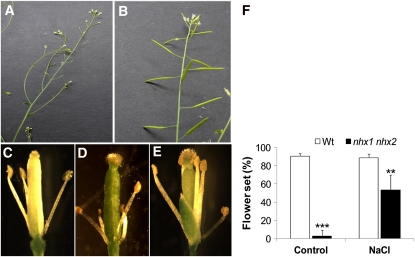Figure 6.
The nhx1 nhx2 Flower Phenotype Is Rescued When Plants Are Grown in High Salt.
Plants were grown in soil under short days (8 h light) for 4 weeks and then irrigated with 50 mM NaCl followed by 100 mM NaCl 2 d later. An additional 25 mM NaCl was included once a week with irrigation. At 5 weeks, the plants were switched to long days (16 h light) to induce flowering. At 7 weeks, flowers were examined.
(A) nhx1 nhx2 inflorescence from plants grown under control conditions showing the characteristic lack of developed siliques.
(B) Inflorescence of nhx1 nhx2 when grown in soil supplemented with 100 mM NaCl.
(C) Dissected wild-type flower showing fully elongated and dehiscent anthers.
(D) Dissected nhx1 nhx2 flower from plants grown without added salt showing short filaments and nondehiscent anthers.
(E) Dissected nhx1 nhx2 flower from plants grown under 100 mM NaCl showing fully elongated and dehiscent anthers.
(F) Comparison of flower set (%) in wild-type (Wt) and nhx1 nhx2 plants grown in the presence and absence of 100 mM NaCl. The primary inflorescence of each of 10 plants was used for counts. ** and ***, significant difference between genotypes (P ≤ 0.01 and P ≤ 0.001, respectively). Values are the mean ± sd (n = 25 flowers). The experiment was repeated twice.
[See online article for color version of this figure.]

